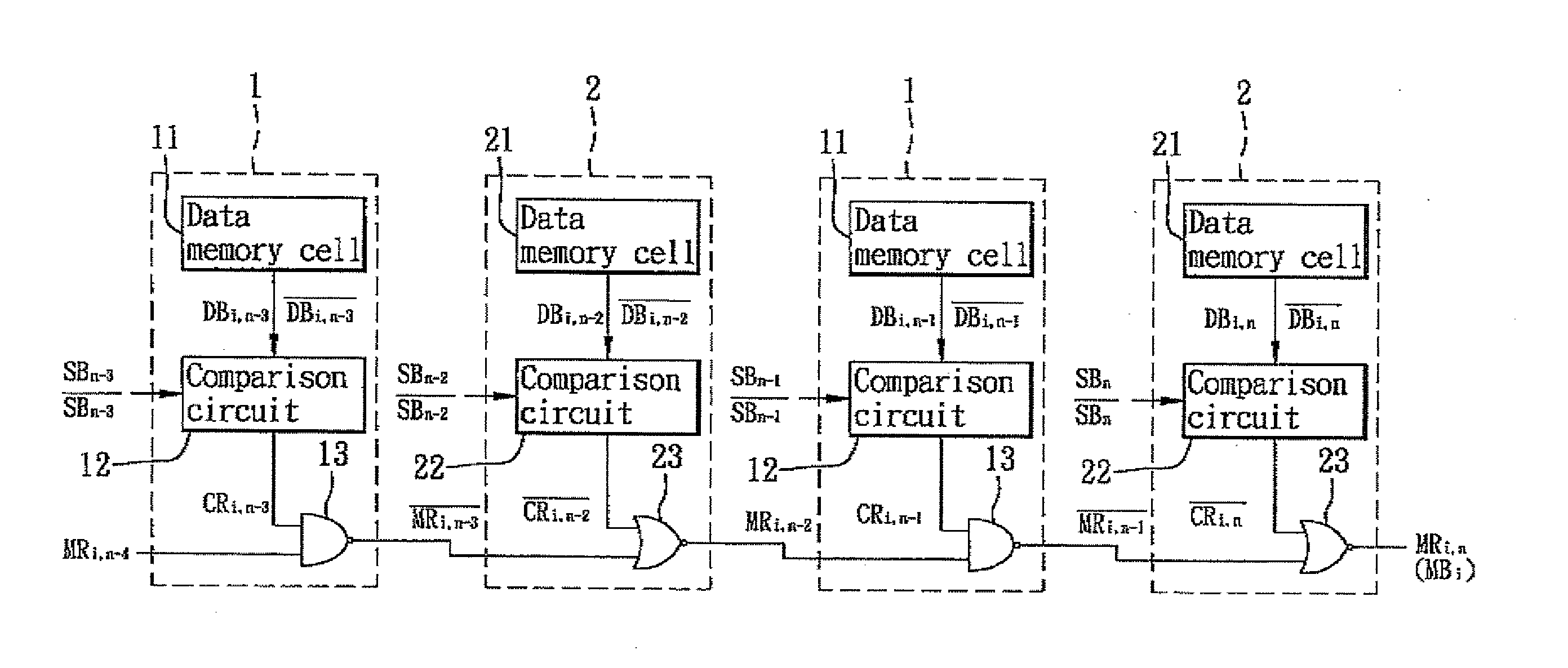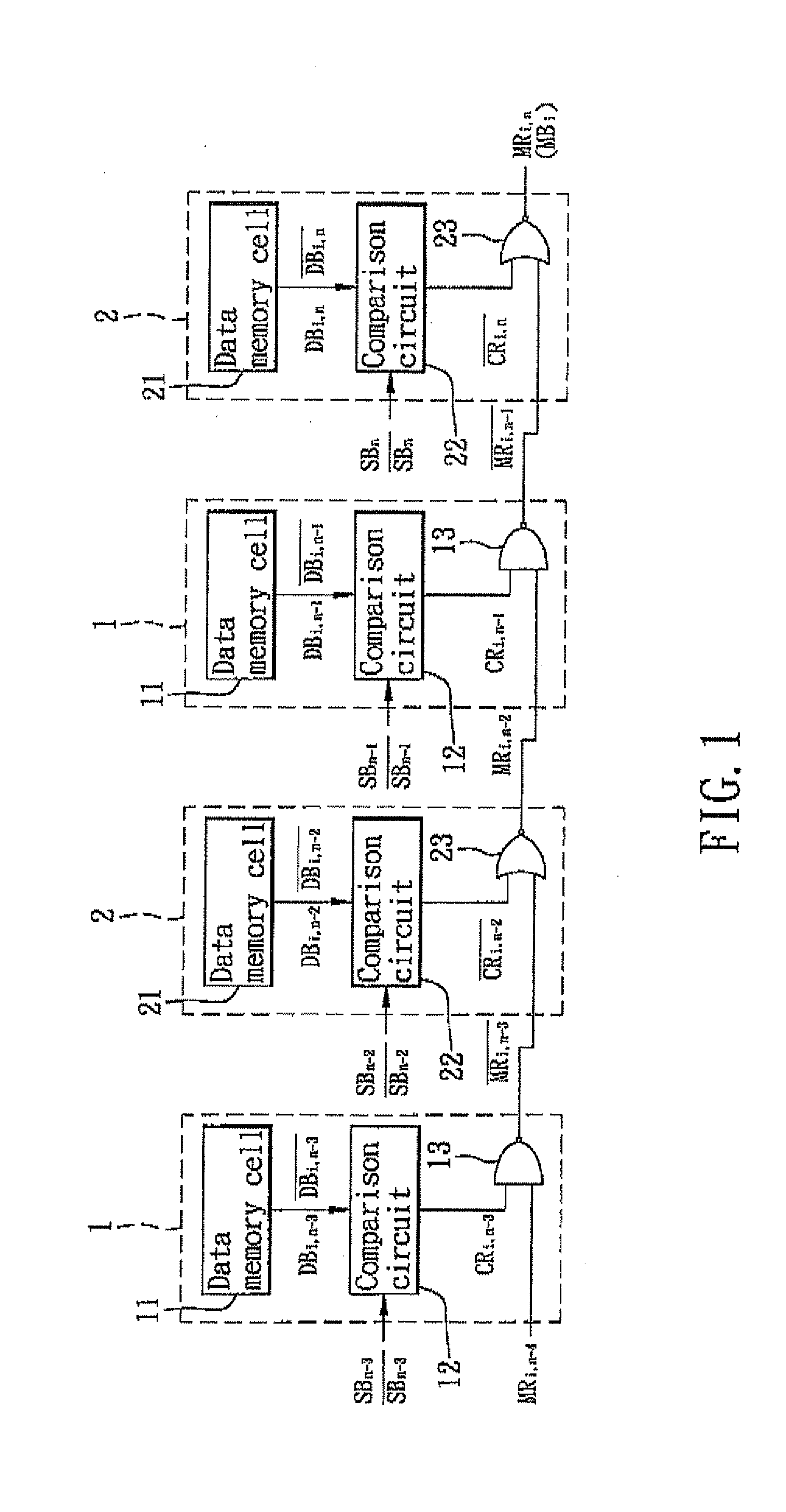Content-Addressable Memory
a content and memory technology, applied in the field of content-addressable memory, can solve the problems of increasing power consumption and overall efficiency, and achieve the effect of high operating speed and low power consumption
- Summary
- Abstract
- Description
- Claims
- Application Information
AI Technical Summary
Benefits of technology
Problems solved by technology
Method used
Image
Examples
first preferred embodiment
[0026]Referring to FIG. 1, the first preferred embodiment of a CAM according to the present invention is a binary CAM, and includes a plurality of memory units 1 and a plurality of memory units 2 (in FIG. 1, only the last four memory units 1, 2 on an ith row are shown). For each row, the memory units 1 are alternatingly disposed with the memory units 2, and each memory unit 1, 2 receives one of the n-number of search bits SBj and one of the n-number of complementary search bits SBj.
[0027]Each memory unit 1 includes a data memory cell 11, a comparison circuit 12, and a static complementary metal-oxide-semiconductor (CMOS) logic circuit 13. The data memory cell 11 stores a data bit DBi,j and a complementary data bit DBi,j. The comparison circuit 12 is coupled to the data memory cell 11, receives the corresponding search bit SBj, the corresponding complementary search bit SBj, and the data bit DBi,j and complementary data bit DBi,j stored in the data memory cell 11, compares the corres...
second preferred embodiment
[0034]Referring to FIG. 3, the second preferred embodiment of a CAM according to the present invention is a binary CAM, and includes a plurality of memory units 3 and a plurality of memory units 4 (in FIG. 3, only the last two memory units 3, 4 on an ith row are shown). For each row, the memory units 3 are alternatingly disposed with the memory units 4, and each memory unit 3, 4 receives two of the n-number of search bits SBj and two of the n-number of complementary search bits SBj.
[0035]Each memory unit 3 includes two data memory cells 31, 32, two comparison circuits 33, 34, and a static CMOS logic circuit 35. The data memory cell 31 stores a data bit DBi,j and a complementary data bit DBi,j. The data memory cell 32 stores a data bit DBi,j-1 and a complementary data bit DBi,j-1. The comparison circuit 33 is coupled to the data memory cell 31, receives the corresponding search bit SBj, the corresponding complementary search bit SBj, and the data bit DBi,j and complementary data bit ...
third preferred embodiment
[0040]Referring to FIG. 6, the third preferred embodiment of a CAM according to the present invention is a ternary CAM, and includes a plurality of memory units 5 and a plurality of memory units 6 (in FIG. 6, only the last four memory units 5, 6 on an ith row are shown). For each row, the memory units 5 are alternatingly disposed with the memory units 6, and each memory unit 5, 6 receives one of the n-number of search bits SBj, and one of the n-number of complementary search bits SBj.
[0041]Each memory unit 5 includes a data memory cell 51, a mask memory cell 52, a comparison circuit 53, and a static CMOS logic circuit 54. The data memory cell 51 stores a data bit DBi,j. The mask memory cell 52 stores a mask bit CBi,j. The comparison circuit 53 is coupled to the data memory cell 51 and the mask memory cell 52, receives the corresponding search bit SBj, the corresponding complementary search bit SBj, the data bit DBi,j stored in data memory cell 51, and the mask bit CBi,j stored in th...
PUM
 Login to View More
Login to View More Abstract
Description
Claims
Application Information
 Login to View More
Login to View More - R&D
- Intellectual Property
- Life Sciences
- Materials
- Tech Scout
- Unparalleled Data Quality
- Higher Quality Content
- 60% Fewer Hallucinations
Browse by: Latest US Patents, China's latest patents, Technical Efficacy Thesaurus, Application Domain, Technology Topic, Popular Technical Reports.
© 2025 PatSnap. All rights reserved.Legal|Privacy policy|Modern Slavery Act Transparency Statement|Sitemap|About US| Contact US: help@patsnap.com



